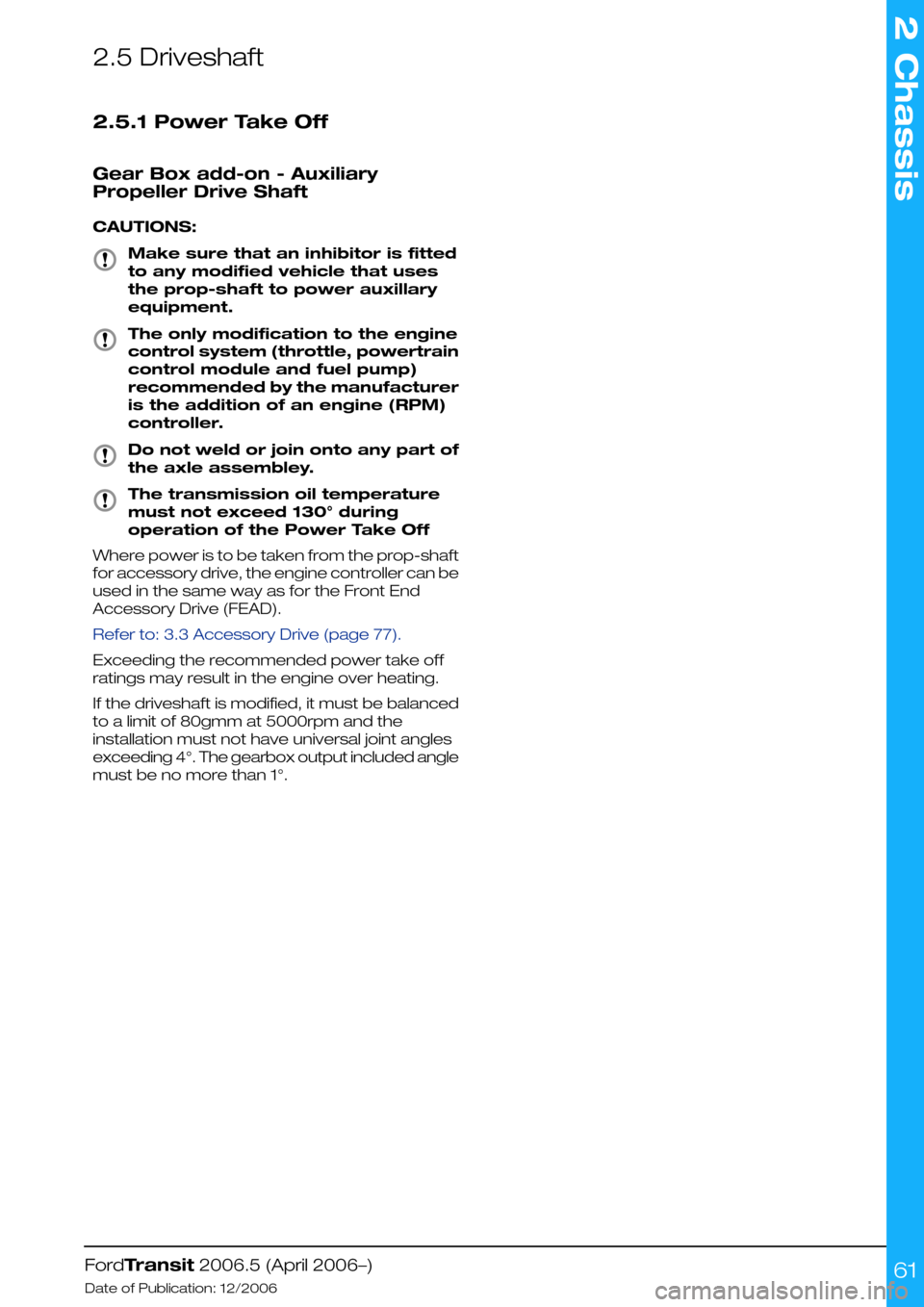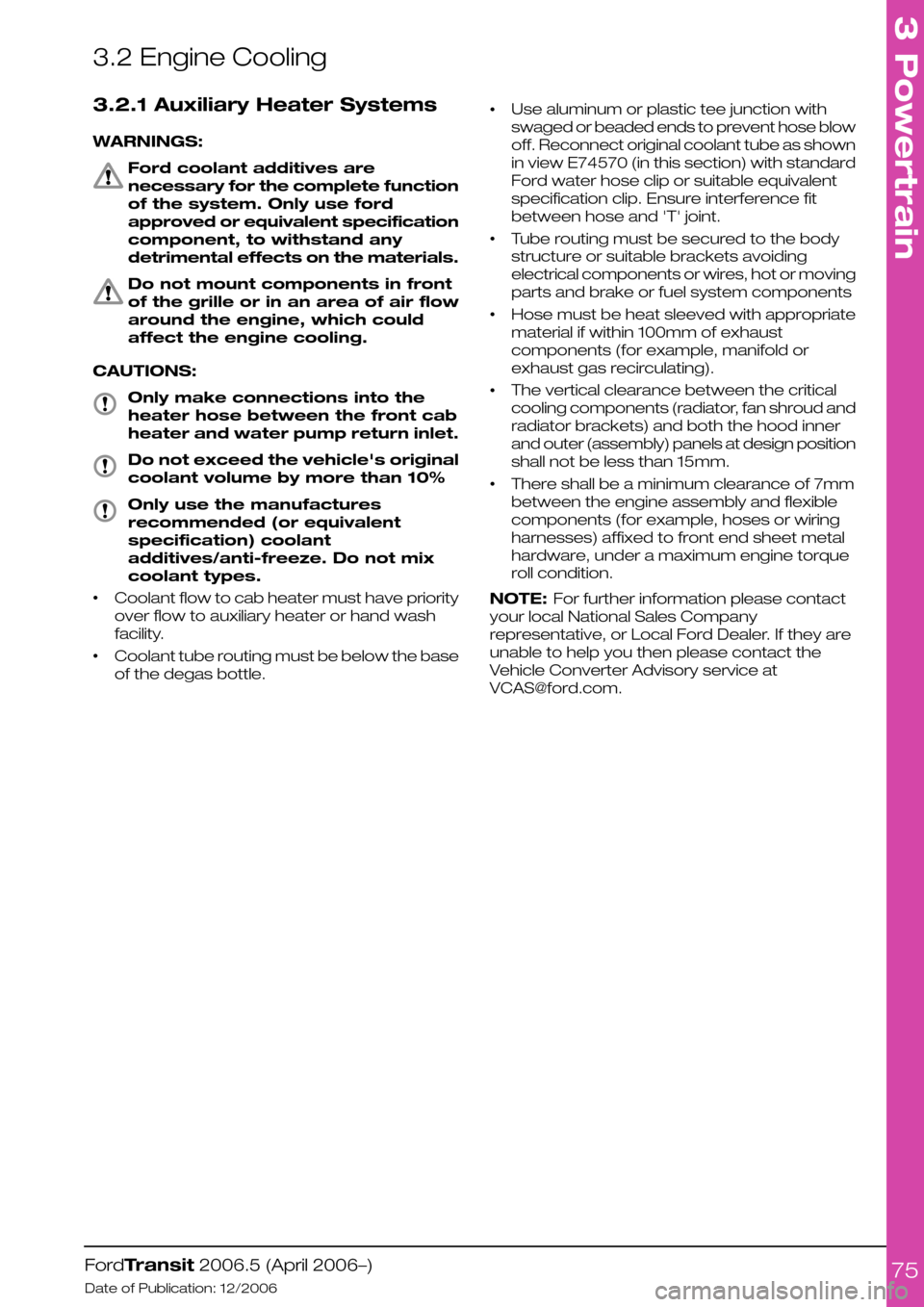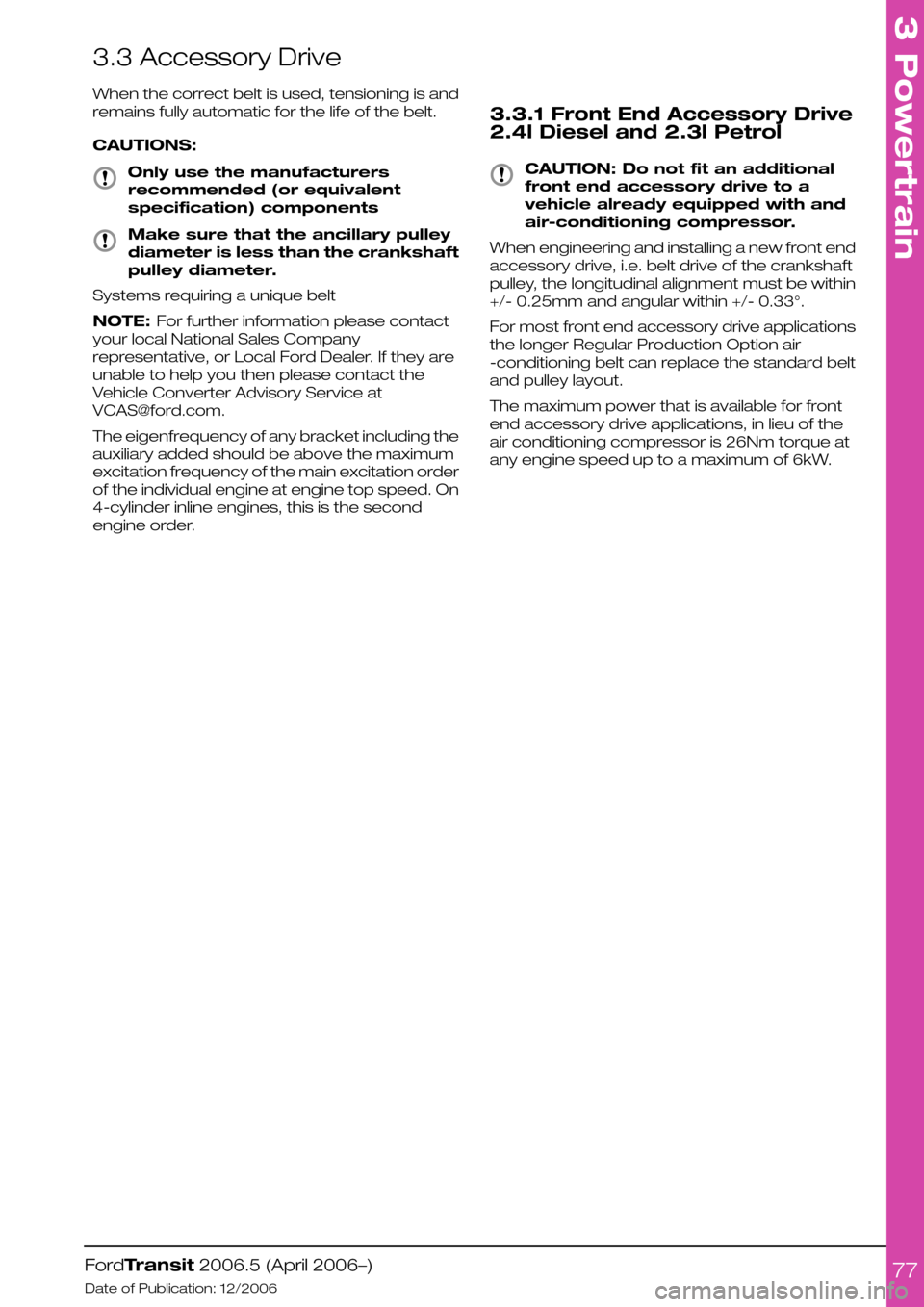2006 FORD TRANSIT AUX
[x] Cancel search: AUXPage 3 of 234

1 General Information
1.1About This Manual........................6
1.1.1Introduction...........................................6
1.1.2Important Safety Instructions.............6
1.1.3Warnings, Cautions and Notes in This
Manual....................................................6
1.1.4How to Use This Manual.....................6
1.2Commercial and Legal Aspects...
7
1.2.1Terminology...........................................7
1.2.2Warranty on Ford Vehicles..................7
1.2.3Legal and Vehicle Type Approval....
7
1.2.4Alternative Type Approval....................7
1.2.5Legal Obligations and Liabilities..........7
1.2.6General Product Safety
Requirement..........................................7
1.2.7Product Liability.....................................8
1.2.8Restraints System................................8
1.2.9Drilling and Welding..............................8
1.2.10Minimum Requirements for Brake
system and Load Apportioning Valves
.................................................................8
1.2.11Road Safety...........................................8
1.3Contact Information.....................9
1.4Conversion Type.........................14
1.5Conversion Homologation.........23
1.6Electromagnetic Compatibility
(EMC)..........................................24
1.6.1Antenna Location...............................24
1.7Vehicle Duty Cycle Guidelines....25
1.7.1Conversion Affect on Fuel Economy
and Performance...............................25
1.7.2Vehicle Ride and Handling
Attributes.............................................25
1.8End of Life Vehicle (ELV)
Directive.....................................26
1.9Jacking.......................................27
1.10Lifting..........................................29
1.11Noise, Vibration and Harshness
(NVH)...........................................31
1.12Vehicle Transportation Aids and
Vehicle Storage..........................32
1.13Package and Ergonomics..........33
1.13.1General Component Package
Guidelines............................................33
1.13.2Driver Reach Zones...........................33
1.13.3Driver Field of View.............................33
1.13.4Conversion Affects on Parking Aids..
33
1.13.5Aids for Vehicle Entry and Exit..........33
1.14Package and
Ergonomics—Specifications......34
1.14.1Recommended Main Dimensions....
34
1.14.2Recommended Nominal Body
Lengths for Chassis Cab models....
36
1.14.3Front, Rear and Side Under-run
Protection............................................38
1.14.4Recommended Main Load Area
Dimensions for Bulkhead with
Depression Driver Side......................39
1.14.5Recommended Main Load Area
Dimensions for Bulkhead with Full
Depression..........................................40
1.14.6Recommended Main Load Area
Dimensions for Double Cab In Van
Bulkhead..............................................41
1.15Hardware—Specifications..........43
1.16Load Distribution—Specifications.
44
1.16.1Load Distribution Calculations - Driver
and Passenger Weight Distribution...
44
1.16.2Center of Gravity ...............................46
1.17Towing........................................54
1.17.1Towing Requirements.......................54
1.17.2Towing..................................................54
2 Chassis
2.1Suspension System....................57
2.2Front Suspension.......................58
2.2.1Springs and Spring Mounting...........58
2.3Rear Suspension........................59
2.3.1Springs and Spring Mounting...........59
2.3.2Rear Anti-Roll Bar...............................59
2.4Wheels and Tires........................60
2.4.1Wheel Clearance................................60
2.4.2Tire Manufacturers.............................60
2.4.3Spare wheel........................................60
2.4.4Painting Road Wheels.......................60
2.5Driveshaft....................................61
2.5.1Power Take Off....................................61
2.6Brake System.............................62
2.6.1General................................................62
2.6.2Kerb Mass Data..................................62
2.6.3Brake Hoses General........................62
2.7Parking Brake.............................63
2.7.1Relocated Parking Brake Lever.......63
2.8Hydraulic Brake Actuation.........64
2.8.1Load Apportioning Valves.................64
2.8.2Front and Rear Brakes......................64
2.9Anti-Lock Control - Stability
Assist..........................................65
3 Powertrain
3.1Engine.........................................66
3.1.1Engine Power Curves.......................66
3.2Engine Cooling............................75
3.2.1Auxiliary Heater Systems..................75
3.2.2Auxiliary Heater Installation...............76
3.2.3Air Flow Restrictions...........................76
3.3Accessory Drive.........................77
3.3.1Front End Accessory Drive 2.4l Diesel
and 2.3l Petrol.....................................77
3.3.2Front End Accessory Drive 2.2l
Diesel....................................................79
3.4Electronic Engine Controls.........81
3.5Clutch.........................................82
3.6Manual Transmission.................83
Table of Contents
3
Page 4 of 234

3.7Exhaust System..........................86
3.7.1Extensions and Optional Exhausts....
86
3.7.2Exhaust Pipes and Supports.............86
3.7.3Exhaust Heat Shields..........................86
3.8Fuel System.................................88
4 Electrical
4.1Communications Network..........90
4.1.1CAN-Bus System Description and
Interface................................................90
4.1.2Central Junction Box (CJB)................91
4.1.3Circuit Diagram....................................93
4.2Module Communications
Network—Specifications.............94
4.2.1Circit Diagram......................................94
4.3Charging System.........................95
4.3.1General Information and Specific
Warnings...............................................95
4.3.2Power Management Settings...........95
4.3.3Electrical Conversions........................95
4.3.4Fitting of Equipment Containing an
Electric Motor.......................................97
4.3.5Vehicle Electrical Capacity -
Alternator..............................................97
4.3.6Charge Balance Guidelines...............97
4.3.7Circuit Diagrams..................................97
4.4Battery and Cables.....................98
4.4.1Battery Information.............................98
4.4.2Generator and Alternator.................103
4.5Climate Control System.............106
4.6Instrument Cluster.....................107
4.7Horn...........................................108
4.8Tachograph................................109
4.8.1Legislation...........................................109
4.8.2Tachograph Mounting.......................110
4.9Information and Entertainment
System - General
Information—Specifications.......112
4.9.1Radio Connector................................112
4.9.2Possible Accessories.........................113
4.10Cellular Phone............................115
4.11Exterior Lighting.........................116
4.11.1Reversing Lamps...............................116
4.11.2Additional External Lamps................116
4.11.3Lamps – Hazard / Direction
Indication..............................................117
4.11.4Lamps – Front and Rear Fog Lights....
117
4.11.5Lamps for Wide Vehicles...................117
4.11.6Electrically operated Door Mirrors....
117
4.12Interior Lighting..........................118
4.12.1Additional Internal Lamps .................118
4.12.2Additional 'Theatre Lighting' for rear
of vehicle interior................................118
4.13Fuses and Relays.......................119
4.13.1Wiring Specification............................119
4.13.2Auxiliary Fuses, Fuse Box and Relays
(Fuses - Standard).............................119
4.13.3Customer Connection Points..........120
4.13.4Special Vehicle Option Auxiliary Fuse
Box........................................................121
4.13.5Additional Ignition, Instrument Panel
Illumination and Air Conditioning On
Signals.................................................124
4.13.6Relays and Switches.........................127
4.13.7Windscreen wipers...........................130
4.14Special Conversions..................131
4.14.1Vehicle Speed Output (Signal).........131
4.14.2Engine Run Signal (D+ Alternative)....
132
4.14.3Connectors.........................................133
4.14.4Installation and Routing Guides.......134
4.14.5Electrics for Tow bar.........................136
4.14.6Ground Points....................................140
4.14.7Special Vehicle Options (SVO) and
Aftermarket Kits.................................146
4.14.8Additional Vehicle Signals / Features..
147
4.14.9Engine RPM (Revs Per Minute) Speed
Controller.............................................157
4.14.10Adding Connectors, Terminals and
Wiring...................................................162
5 Body and Paint
5.1Body...........................................175
5.1.1Body Structures - General
Information..........................................175
5.1.2Back Panel Removal.........................177
5.1.3Integrated Bodies and Conversions...
177
5.1.4Chassis Cab........................................179
5.1.5Cab Van Floor.....................................185
5.1.6Hydraulic Lifting Equipment for Van,
Bus, Kombi and Chassis Cab..........186
5.1.7Partitions (Bulkhead) - Driver and
Front Passenger(s) Protection on Van,
Bus and Kombi..................................192
5.1.8Racking Systems...............................194
5.1.9Front End Integrity for Cooling, Crash,
Aerodynamics and Lighting.............198
5.1.10Tipper Bodies.....................................199
5.1.11Tank and Dry Bulk Carriers...............199
5.2Body System - General
Information—Specifications......200
5.2.1Van Floor - Load Compartment Tie
Downs for Van ,Bus and Kombi.....200
5.3Body Closures..........................203
5.3.1Load Compartment Interior Lining....
203
5.3.2Security, Anti Theft and Locking
System Security ...............................203
5.4Rear View Mirrors.....................208
5.4.1Mirrors for Wide Vehicles.................208
5.5Seats.........................................209
5.5.1Rear Seat Fixings Positions - Kombi...
209
5.5.2Heated Seats.....................................210
5.6Glass, Frames and Mechanisms...
211
5.6.1Rear Windows....................................211
Table of Contents
4
Page 61 of 234

2.5 Driveshaft
2.5.1 Power Take Off
Gear Box add-on - Auxiliary
Propeller Drive Shaft
CAUTIONS:
Make sure that an inhibitor is fitted
to any modified vehicle that uses
the prop-shaft to power auxillary
equipment.
The only modification to the engine
control system (throttle, powertrain
control module and fuel pump)
recommended by the manufacturer
is the addition of an engine (RPM)
controller.
Do not weld or join onto any part of
the axle assembley.
The transmission oil temperature
must not exceed 130° during
operation of the Power Take Off
Where power is to be taken from the prop-shaft
for accessory drive, the engine controller can be
used in the same way as for the Front End
Accessory Drive (FEAD).
Refer to: 3.3 Accessory Drive (page 77).
Exceeding the recommended power take off
ratings may result in the engine over heating.
If the driveshaft is modified, it must be balanced
to a limit of 80gmm at 5000rpm and the
installation must not have universal joint angles
exceeding 4°. The gearbox output included angle
must be no more than 1°.
FordTransit 2006.5 (April 2006–)
Date of Publication: 12/2006
2 Chassis
61
Page 66 of 234

3.1 Engine
CAUTION: Make sure to follow the
equipment suppliers instructions for
safety, warranty and sometimes
legal compliance
For electrical supply to auxiliary equipment.
Refer to: 4.3 Charging System (page 95).
3.1.1 Engine Power Curves
The torque and power curves of the following
engines are shown in this section
•Common Rail 2.2L TCI 62.5kW (85HP) Diesel
Engine
•Common Rail 2.2L TCI 81kW (110HP) Diesel
Engine
•Common Rail 2.2L TCI 96kW (130HP) Diesel
Engine
•Common Rail 2.4L TCI 74kW (100HP) Diesel
Engine
•Common Rail 2.4L TCI 85kW (115HP) Diesel
Engine
•Common Rail 2.4L TCI 103kW (140HP) Diesel
Engine
•2.3L Gasoline engine 107kW (145HP)
FordTransit 2006.5 (April 2006–)
Date of Publication: 12/2006
3 Powertrain
66
Page 75 of 234

3.2 Engine Cooling
3.2.1 Auxiliary Heater Systems
WARNINGS:
Ford coolant additives are
necessary for the complete function
of the system. Only use ford
approved or equivalent specification
component, to withstand any
detrimental effects on the materials.
Do not mount components in front
of the grille or in an area of air flow
around the engine, which could
affect the engine cooling.
CAUTIONS:
Only make connections into the
heater hose between the front cab
heater and water pump return inlet.
Do not exceed the vehicle's original
coolant volume by more than 10%
Only use the manufactures
recommended (or equivalent
specification) coolant
additives/anti-freeze. Do not mix
coolant types.
•Coolant flow to cab heater must have priority
over flow to auxiliary heater or hand wash
facility.
•Coolant tube routing must be below the base
of the degas bottle.
•Use aluminum or plastic tee junction with
swaged or beaded ends to prevent hose blow
off. Reconnect original coolant tube as shown
in view E74570 (in this section) with standard
Ford water hose clip or suitable equivalent
specification clip. Ensure interference fit
between hose and 'T' joint.
•Tube routing must be secured to the body
structure or suitable brackets avoiding
electrical components or wires, hot or moving
parts and brake or fuel system components
•Hose must be heat sleeved with appropriate
material if within 100mm of exhaust
components (for example, manifold or
exhaust gas recirculating).
•The vertical clearance between the critical
cooling components (radiator, fan shroud and
radiator brackets) and both the hood inner
and outer (assembly) panels at design position
shall not be less than 15mm.
•There shall be a minimum clearance of 7mm
between the engine assembly and flexible
components (for example, hoses or wiring
harnesses) affixed to front end sheet metal
hardware, under a maximum engine torque
roll condition.
NOTE: For further information please contact
your local National Sales Company
representative, or Local Ford Dealer. If they are
unable to help you then please contact the
Vehicle Converter Advisory service at
[email protected].
FordTransit 2006.5 (April 2006–)
Date of Publication: 12/2006
3 Powertrain
75
Page 76 of 234

Water Hoses for Auxiliary Heating System
DescriptionItem
Connector (aluminum or plastic)1
Heater hose - maintain heater fluid2
Original flow3
To ancillary equipment4
3.2.2 Auxiliary Heater Installation
For an auxiliary heating system it must be ensured
that the exhaust gas of such a system cannot be
re-circulated into the vehicle. The exhaust gases
must not pass into the engine intake system or
the air intake for the passenger compartment
ventilation. The heating system should be installed
outside the passenger compartment. The
location of the heating system should not be in
close proximity to movable components. Any
body reworks which damage the paint must be
fully protected against corrosion.
Refer to: 5.10 Corrosion Prevention (page 221).
NOTE: The installation must be in line with the
appropriate legal requirements
3.2.3 Air Flow Restrictions
WARNING: Do not mount
components in front of the grille or
in an area of air flow around the
engine, which could affect the
engine cooling performance.
CAUTION: Over heating within the
engine compartment can seriously
compromise component robustness.
NOTE: For further information please contact
your local National Sales Company representative,
or Local Ford Dealer. If they are unable to help
you then please contact the Vehicle Converter
Advisory Service at [email protected].
FordTransit 2006.5 (April 2006–)
Date of Publication: 12/2006
3 Powertrain
76E745701234
Page 77 of 234

3.3 Accessory Drive
When the correct belt is used, tensioning is and
remains fully automatic for the life of the belt.
CAUTIONS:
Only use the manufacturers
recommended (or equivalent
specification) components
Make sure that the ancillary pulley
diameter is less than the crankshaft
pulley diameter.
Systems requiring a unique belt
NOTE: For further information please contact
your local National Sales Company
representative, or Local Ford Dealer. If they are
unable to help you then please contact the
Vehicle Converter Advisory Service at
[email protected].
The eigenfrequency of any bracket including the
auxiliary added should be above the maximum
excitation frequency of the main excitation order
of the individual engine at engine top speed. On
4-cylinder inline engines, this is the second
engine order.
3.3.1 Front End Accessory Drive
2.4l Diesel and 2.3l Petrol
CAUTION: Do not fit an additional
front end accessory drive to a
vehicle already equipped with and
air-conditioning compressor.
When engineering and installing a new front end
accessory drive, i.e. belt drive of the crankshaft
pulley, the longitudinal alignment must be within
+/- 0.25mm and angular within +/- 0.33°.
For most front end accessory drive applications
the longer Regular Production Option air
-conditioning belt can replace the standard belt
and pulley layout.
The maximum power that is available for front
end accessory drive applications, in lieu of the
air conditioning compressor is 26Nm torque at
any engine speed up to a maximum of 6kW.
FordTransit 2006.5 (April 2006–)
Date of Publication: 12/2006
3 Powertrain
77
Page 88 of 234

3.8 Fuel System
WARNINGS:
Do not cut into the original fuel
supply lines
Make sure that the modified vehicle
complies with all relevant legal
requirements.
For auxiliary applications requiring a fuel supply,
it is advisable to use the auxiliary fuel supply port
as shown in the figure below.
•The auxiliary fuel supply port is mounted on
the top of the fuel sender unit located on the
top of the fuel tank, for applications such as
an auxiliary heater or fuel fired hand wash
facility.
•Ensure that a suitable fuel shut-off is fitted in
any unique system.
•Refit the Ford hose assembly from the fuel
pump to the fuel line.
•The tube and/or line must be routed
independently and secured to the body
structure or to suitable brackets.
CAUTION: Make sure that sufficient
clearance is maintained for all
driving conditions to all hot and
moving components.
NOTE: Do not fasten anything to existing
electrical components or wires
FordTransit 2006.5 (April 2006–)
Date of Publication: 12/2006
3 Powertrain
88